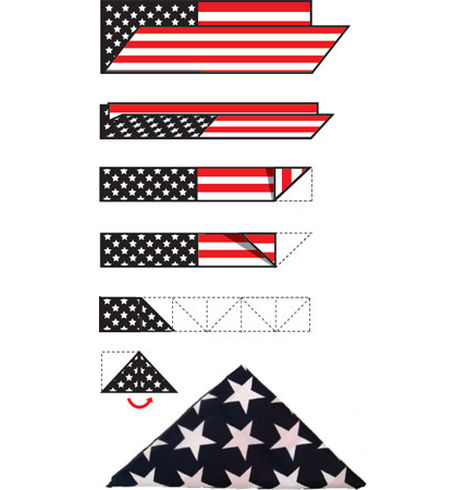Federal law stipulates many aspects of flag etiquette. The section of law dealing with American Flag etiquette is generally referred to as the Flag Code. Some general guidelines from the Flag Code answer many of the most common questions:
• The flag should be lighted at all times, either by sunlight or by an appropriate light source.
• The flag should be flown in fair weather, unless the flag is designed for inclement weather use.
• The flag should never be dipped to any person or thing. It is flown upside down only as a distress signal.
• The flag should not be used for any decoration in general. Bunting of blue, white and red stripes is available for these purposes. The blue stripe of the bunting should be on the top.
• The flag should never be used for any advertising purpose. It should not be embroidered, printed or otherwise impressed on such articles as cushions, handkerchiefs, napkins, boxes, or anything intended to be discarded after temporary use. Advertising signs should not be attached to the staff or halyard.
• The flag should not be used as part of a costume or athletic uniform, except that a flag patch may be used on the uniform of military personnel, fireman, policeman and members of patriotic organizations.
• The flag should never have any mark, insignia, letter, word, number, figure, or drawing of any kind placed on it, or attached to it.
• The flag should never be used for receiving, holding, carrying, or delivering anything.
• When the flag is lowered, no part of it should touch the ground or any other object; it should be received by waiting hands and arms. To store the flag it should be folded neatly and ceremoniously.
• The flag should be cleaned and mended when necessary.
• When a flag is so worn it is no longer fit to serve as a symbol of our country, it should be destroyed by burning in a dignified manner.
Rules for Display of the American Flag
Display Outdoors
Over the Middle of the Street It should be suspended vertically with the union to the north in an east and west street or to the east in a north and south street.
Flown at Half-staff
Should be first hoisted to the peak for an instant and then lowered to the half-staff position. The flag should be again raised to the peak before it is lowered for the day. By "half-staff" is meant lowering the flag to one-half the distance between the top and bottom of the staff. Crepe streamers may be affixed to spear heads or flagstaffs in a parade only by order of the President of the United States.
Flown on the Same Halyard with Non-Nation Flags
The American Flag should always be at the peak. When the flags are flown from adjacent staffs, the flag of the United States should be hoisted first and lowered last. No such flag or pennant may be placed above the flag of the United States or to the right of the flag of the United States.
Suspended Over a Sidewalk
The flag may be suspended from a rope extending from a house to a pole at the edge of the sidewalk, the flag should be hoisted out, union first, from the building.
From a Staff Projecting Horizontally or at an Angle
The flag may be projected from the window sill, balcony, or front of a building, with the union of the flag placed at the peak of the staff unless the flag is at half-staff.
In a Parade with Other Flags
The flag, when carried in a procession with another flag, or flags, should be either on the marching right; that is, the flag's own right, or, if there is a line of other flags, in front of the center of that line.
With Non-National Flags
The flag of the United States of America should be at the center and at the highest point of the group when a number of flags of States or localities or pennants of societies are grouped and displayed from staffs.
With Other National Flags
When flags of two or more nations are displayed, they are to be flown from separate staffs of the same height. The flags should be of approximately equal size. International usage forbids the display of the flag of one nation above that of another nation in time of peace.
With Another Flag Against a Wall from Crossed Staffs
Should be on the right, the flag's own right which is the viewer's left, and its staff should be in front of the staff of the other flag.
Display Indoors
From a Staff in a Church or Public Auditorium on a Podium
The flag of the United States of America should hold the position of superior prominence, in advance of the audience, and in the position of honor at the clergyman's or speaker's right as he faces the audience. Any other flag so displayed should be placed on the left of the clergyman or speaker (to the right of the audience).
From a Staff in a Church or Public Auditorium off the Podium
Custom and not the flag code hold that the flag of the United States of America should hold the position of superior prominence as part of the audience, in the position of honor at the audience's right.
Used to Cover a Casket
It should be so placed that the union is at the head and over the left shoulder. The flag should not be lowered into the grave or allowed to touch the ground.
Other than being Flown from a Staff
The flag should be displayed flat, whether indoors or out. When displayed either horizontally or vertically against a wall, the union should be uppermost and to the flag's own right, that is, to the observer's left. When displayed in a window it should be displayed in the same way, that is with the union or blue field to the left of the observer in the street. When festoons, rosettes or drapings are desired, bunting of blue, white and red should be used, but never the flag.
Folding the Flag


